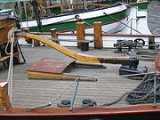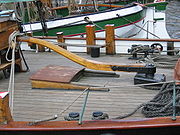
Tiller
Encyclopedia

Lever
In physics, a lever is a rigid object that is used with an appropriate fulcrum or pivot point to either multiply the mechanical force that can be applied to another object or resistance force , or multiply the distance and speed at which the opposite end of the rigid object travels.This leverage...
attached to a rudder post (American terminology) or rudder stock (English terminology) of a boat that provides leverage for the helmsman
Helmsman
A helmsman is a person who steers a ship, sailboat, submarine, or other type of maritime vessel. On small vessels, particularly privately-owned noncommercial vessels, the functions of skipper and helmsman may be combined in one person. On larger vessels, there is a separate officer of the watch,...
to turn the rudder
Rudder
A rudder is a device used to steer a ship, boat, submarine, hovercraft, aircraft or other conveyance that moves through a medium . On an aircraft the rudder is used primarily to counter adverse yaw and p-factor and is not the primary control used to turn the airplane...
. The tiller is normally used by the helmsman directly pulling or pushing it, but it may also be moved remotely using tiller lines.
Rapid or excessive movement of the tiller results in an increase in drag and will result in braking or slowing the boat. In steering a boat, the tiller is always moved in the direction opposite of which the bow of the boat is to move. If the tiller is moved to port side (left), the bow will turn to starboard (right). If the tiller is moved to starboard (right), the bow will turn port (left). Sailing students often learn the alliterative phrase "Tiller Towards Trouble" to remind them of how to steer.
Ship's wheel
As the size of boat increases the force needed to control the rudder via a tiller becomes excessive. In the 21st century, a steering wheel tends to be used instead of a tiller on new boats with an overall length in excess of approximately 10 metres, except on narrowboats on English canals, where boats up to 22 metres long and steered by a tiller are being built. Although the wheel replaced the tiller as the direct means of controlling the vessel the tiller was still present, connected as before to the top of the rudder. However it was now moved by mechanical means controlled by a wheel (by ropes or cables on smaller vessels and ultimately by a hydraulically-controlled steam engine on large steamships).In modern boats emergency tillers are often carried in case the steering wheel on a vessel fails to operate.
Tiller orders
Until the current international standards were applied in the 1930s, it was common for steering orders on ships to be given as "Tiller Orders", which dictated to which side of the vessel the tiller was to be moved. Since the tiller is forward of the rudder's pivot point, and the rudder aft of it, the tiller's movement is reversed at the rudder, giving the impression that orders were given "the wrong way round". For example, to turn a ship to port (its left side), the helmsmanHelmsman
A helmsman is a person who steers a ship, sailboat, submarine, or other type of maritime vessel. On small vessels, particularly privately-owned noncommercial vessels, the functions of skipper and helmsman may be combined in one person. On larger vessels, there is a separate officer of the watch,...
would be given the order "starboard helm" or "x degrees starboard". The ship's tiller was then moved to starboard, turning the rudder to the vessel's port side, producing a turn to port. The opposite convention applied in France (where tribord—starboard—meant turn to starboard), but Austria and Italy kept to the English system. There was no standardization in vessels from Scandinavian countries, where the practice varied from ship to ship. Most French vessels with steering wheels had their steering chains reversed and when under the command of a British pilot this could result in confusion.
When large steamships appeared in the late 19th century with telemotors hydraulically connecting the wheel on the bridge
Bridge (ship)
The bridge of a ship is the room or platform from which the ship can be commanded. When a ship is underway the bridge is manned by an OOW aided usually by an AB acting as lookout...
to the steering gear at the stern
Stern
The stern is the rear or aft-most part of a ship or boat, technically defined as the area built up over the sternpost, extending upwards from the counter rail to the taffrail. The stern lies opposite of the bow, the foremost part of a ship. Originally, the term only referred to the aft port section...
, the practice continued. However the helmsman was now no longer directly controlling the tiller, and the ship's wheel was simply turned in the desired direction (turn the wheel to port and the ship will go to port). Tiller Orders remained however: although many maritime nations had abandoned the convention by the end of the 19th century, Britain retained it until 1933 and the U.S. merchant marine until 1935. One of the reasons for this system continuing, apart from it being a long-established maritime tradition, was that it provided consistency—regardless of whether a vessel was steered directly by the tiller or remotely by a wheel every vessel had a tiller of some sort and so a tiller order remained true for any vessel. During the transition period the wording of the order was changed, to specify "Wheel to starboard" or "Wheel to port".
A well-known and often-depicted example occurred on the RMS Titanic in 1912 just before she collided with an iceberg
Iceberg
An iceberg is a large piece of ice from freshwater that has broken off from a snow-formed glacier or ice shelf and is floating in open water. It may subsequently become frozen into pack ice...
. When the iceberg appeared directly in front of the ship, her officer-of-the-watch, First Officer William Murdoch
William McMaster Murdoch
Lieutenant William "Will" McMaster Murdoch RNR was a Scottish sailor who died on board the , where he was employed by the White Star Line, serving as First Officer...
, decided to attempt to clear the berg by swinging the ship to its port side. He ordered 'Hard-a-Starboard', which was a Tiller Order directing the helmsman to turn the wheel to port (anti-clockwise) as far as it would go. The Titanic's steering gear then pushed the tiller toward the starboard side of the ship, swinging the rudder over to port and causing the vessel to turn to port. These actions are faithfully portrayed in the 1997 film
Titanic (1997 film)
Titanic is a 1997 American epic romance and disaster film directed, written, co-produced, and co-edited by James Cameron. A fictionalized account of the sinking of the RMS Titanic, it stars Leonardo DiCaprio as Jack Dawson, Kate Winslet as Rose DeWitt Bukater and Billy Zane as Rose's fiancé, Cal...
of the disaster. Although frequently described as an error, it is correct.
Although this system seems confusing and contradictory today, to generations of sailor
Sailor
A sailor, mariner, or seaman is a person who navigates water-borne vessels or assists in their operation, maintenance, or service. The term can apply to professional mariners, military personnel, and recreational sailors as well as a plethora of other uses...
s trained on sailing vessels with tiller steering it seemed perfectly logical and was understood by all seafarers. Only when new generations of sailors trained on ships with wheel-and-tiller steering came into the industry was the system replaced.
Tillers on other vehicles
The first automobileAutomobile
An automobile, autocar, motor car or car is a wheeled motor vehicle used for transporting passengers, which also carries its own engine or motor...
s were steered with a tiller, but a steering wheel
Steering wheel
A steering wheel is a type of steering control in vehicles and vessels ....
was first used in Europe in 1894 and became standard on French Panhard
Panhard
Panhard is currently a French manufacturer of light tactical and military vehicles. Its current incarnation was formed by the acquisition of Panhard by Auverland in 2005. Panhard had been under Citroën ownership, then PSA , for 40 years...
cars in 1898. In the USA Packard
Packard
Packard was an American luxury-type automobile marque built by the Packard Motor Car Company of Detroit, Michigan, and later by the Studebaker-Packard Corporation of South Bend, Indiana...
introduced a steering wheel on the second car they built, in 1899. By early in the next century, the steering wheel had nearly entirely replaced the tiller in automobiles. However, some automobiles still used Tiller into the teens, such as Rauch & Lang Carriage Co. of Cleveland, Ohio. It manufactured electric automobiles.
Arthur Constantin Krebs
Arthur Krebs
Arthur Constantin Krebs was a French officer and pioneer in automotive engineering....
replaced the tiller with an inclined steering wheel for the Panhard & Levassor car he designed for the Paris-Amsterdam race which ran from the 7–13 July 1898.
Today tractor-drawn semi-trailers for ladder trucks utilize a "tiller" (rear steering axle) driver to control the trailer where the aerial ladder is located.
Some jetliners, such as the Boeing 737
Boeing 737
The Boeing 737 is a short- to medium-range, twin-engine narrow-body jet airliner. Originally developed as a shorter, lower-cost twin-engine airliner derived from Boeing's 707 and 727, the 737 has developed into a family of nine passenger models with a capacity of 85 to 215 passengers...
, use a tiller to steer while taxiing
Taxiing
Taxiing refers to the movement of an aircraft on the ground, under its own power, in contrast to towing or push-back where the aircraft is moved by a tug...
.
Recumbent bicycle
Recumbent bicycle
A recumbent bicycle is a bicycle that places the rider in a laid-back reclining position. Most recumbent riders choose this type of design for ergonomic reasons; the rider's weight is distributed comfortably over a larger area, supported by back and buttocks...
s often use tiller steering.
Mobility Scooter
Mobility scooter
A mobility scooter is a mobility aid equivalent to a wheelchair but configured like a motorscooter. It is often referred to as a power-operated vehicle/scooter or electric scooter as well.-Description:...
s use tiller steering.
Some Kayaks which have foot pedals use a tiller for steering.

